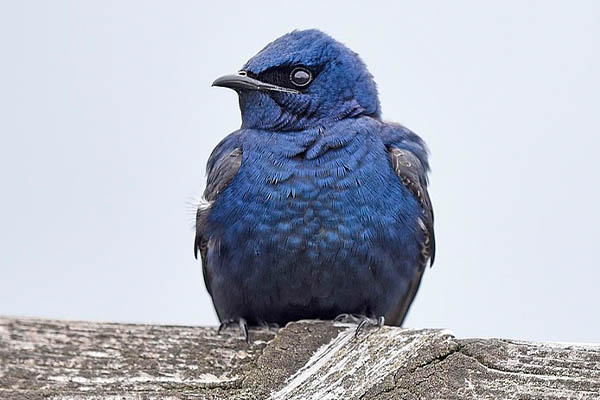
The Minnesota Breeding Bird Atlas project shows that purple martin colonies are well scattered across Minnesota where human density is relatively high, particularly in lake country. I find this whole situation to be kind of unexpected, don’t you? With this conversion to nesting in birdhouses, people seem to be the ticket to the reproductive future of purple martins. Yet in western North America purple martins still nest mostly in woodpecker holes or natural cavities. The last nesting of martins in natural tree cavities in Minnesota is believed to be a colony known in the mid-1960s. The eastern continental population of purple martins began using artificial nest houses, and now cannot be found in a natural cavity in the woods. It’s thought that wooded ponds and beaver marshes were favored. Purple martins historically lived along forest edges and riparian areas, nesting in old woodpecker holes. When I got to checking into some of the literature about martins, I was surprised at just how much I didn’t know about them. But in Minnesota purple martin populations have declined about 70% since the beginning of the Breeding Bird Survey in 1966. I’ve lived around purple martins all my life, so I guess I have taken their presence for granted. Have you ever seen a martin fly low over the water, hitting it time and again? Did you know that he is taking a bath? Martins gather all their food while flying they drink by dipping down to water while in flight. Even very young martins are good flyers when they just leave the nest. They can descend very quickly from up high, hurtling downwards in an almost vertical dive, and then pull out just before they get to the nest site. Purple martins sail around in circles, flapping and gliding. Martins eat bugs, beetles, flies, dragonflies, butterflies, and the like. That is because martins feed high and during daylight hours mosquitoes fly low and more often at night. I am sorry to report there is no credible evidence they eat many mosquitoes. I love their gurgling twitter! They fly higher to feed than do other swallows to feed. Martins have loud voices, and there are usually quite a few of them. The largest of the North American swallows, purple martins are distinguished by their use of artificial nest boxes, flight pattern, and noisy song. Near dusk there’s an influx of many birds, and previously empty nest boxes are once again full. Some babies seem to have left their nests others are still being fed in the nests. It’s a busy time as the martins raise their nests of young, and it’s confusing at times to figure out just exactly what is going on. It’s more pleasant beside the lake, and the resident purple martin colony provides a fun distraction. At my folks’ place we have been sitting out for a bit in the evenings, seeking a bit of breeze. If you’re at all like my people, you’re struggling in the hot weather we’ve had lately. These two species are non-native and any nesting attempt by these two species should be thwarted as soon as possible.By Kelly Barrett, Wildlife Biologist - Chippewa National Forest Learn to recognize House Sparrows and the European Starling.

Other considerations when selecting a purple martin house Prospective martin landlords can play a tape of the martin dawn song in late spring to enhance the chance of establishing the initial colony. Sometimes adding a few gourds below a martin “apartment” will help attract birds the first year.Īfter mating and nesting has commenced, adult male martins will fly above the colony early in the morning and sing the “dawn song.” The song proclaims the presence of a successful colony and the males hope to attract sub-adult females to the area. Make sure your house is white (colored trim is OK). Martins seem to be most attracted to white houses, which provide the best cooling on hot summer days. Houses opened too early attract competing species and those opened too late will find that the martins have already located nesting sites for the year.

You can place the martin house within 100 feet of your house. Martins seem to adapt better when the martin house is placed close to human activity. Housing placed too close to trees or wires will be ignored. Houses need at least 40 feet of clear air space to provide easy access to the nest site. Keep these thoughts in mind when locating the martin house. Starting your initial Purple Martin colony can be a challenge.


 0 kommentar(er)
0 kommentar(er)
